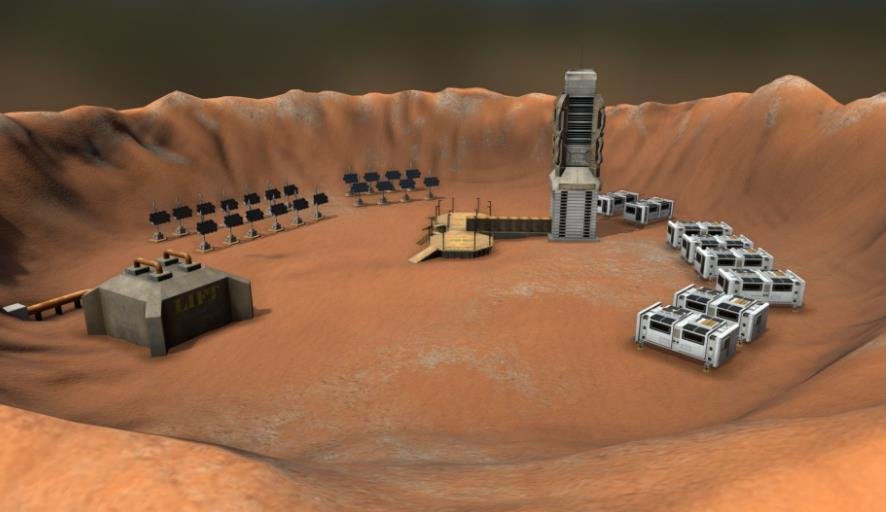Lockheed Martin, a leading aerospace and defense company, has been developing a concept for a human mission to Mars that involves an orbiting base camp and a reusable lander. The company claims that this approach is more feasible and sustainable than a direct landing on the Martian surface.
The Mars Base Camp (MBC) is Lockheed Martin’s vision for sending humans to Mars in about a decade. The MBC is a space station that would orbit around Mars and serve as a base for multiple 14-day crewed expeditions on the planet and its moons, Phobos and Deimos. The MBC would also enable telerobotic exploration of the Martian surface, including sample return.
The MBC would consist of several modules, such as a habitat, a laboratory, a propulsion system, a docking port, and a solar array. The modules would be launched separately and assembled in orbit around Mars. Some elements, such as the propulsion system and the lander, would use nuclear thermal propulsion (NTP), which is a technology that Lockheed Martin has been selected to demonstrate in space.
The lander, which is called the Mars Ascent/Descent Vehicle (MADV), would be capable of carrying four astronauts to and from the Martian surface. The MADV would use a single stage to orbit design, which means that it would not need to discard any parts during the ascent or descent. The MADV would be refueled at the MBC using oxygen and hydrogen generated from water by solar-powered electrolysis.

Why is the MBC worth the wait?
According to Lockheed Martin, the MBC offers several advantages over a direct landing on Mars. First, the MBC would allow for more flexibility and safety in exploring different sites on Mars, as well as its moons. The astronauts would be able to choose the most interesting and promising locations based on the data collected by the orbiting station and the telerobots. The astronauts would also have the option to abort or postpone a landing in case of an emergency or unfavorable weather conditions.
Second, the MBC would reduce the risks and challenges associated with landing and taking off from Mars. The MADV would only need to overcome the gravity and atmosphere of Mars, which are much lower than those of Earth. The MADV would also avoid the dust storms and temperature extremes that can affect the performance and reliability of the landing systems. Moreover, the MADV would not need to carry any extra mass or complexity for re-entry into Earth’s atmosphere.
Third, the MBC would enable more scientific discoveries and benefits for humanity. The MBC would allow for longer-duration missions and more frequent visits to Mars than a single-shot landing. The MBC would also facilitate the return of Martian samples to Earth for further analysis and study. Furthermore, the MBC would serve as a testbed for future missions to other destinations in the solar system, such as asteroids or moons.
How realistic is the MBC?
The MBC is not just a theoretical concept, but a realistic proposal based on existing or near-term technologies. Lockheed Martin has been working on various aspects of the MBC for several years, such as designing the modules, testing the NTP system, developing the telerobotic capabilities, and simulating the operations. The company has also been collaborating with NASA and other partners to align its vision with their goals and requirements.
However, the MBC is not without its challenges and uncertainties. The MBC would require a significant amount of funding, coordination, and political support from various stakeholders. The MBC would also depend on the availability and reliability of several launch vehicles, such as NASA’s Space Launch System (SLS) and Orion spacecraft. The MBC would also face technical issues, such as radiation exposure, orbital debris, communication delays, and human factors.
The MBC is not the only option for sending humans to Mars. Other proposals include SpaceX’s Starship system, which aims to land humans directly on Mars using reusable rockets; NASA’s Artemis program, which plans to establish a lunar gateway as a staging point for Mars missions; and Mars Direct, which advocates for sending humans directly to Mars using existing technology.
Ultimately, the choice of how to go to Mars depends on various factors, such as cost, risk, schedule, science, exploration, and inspiration. Lockheed Martin believes that its MBC concept offers a balanced and pragmatic solution that can accelerate the journey to Mars while ensuring its sustainability.
